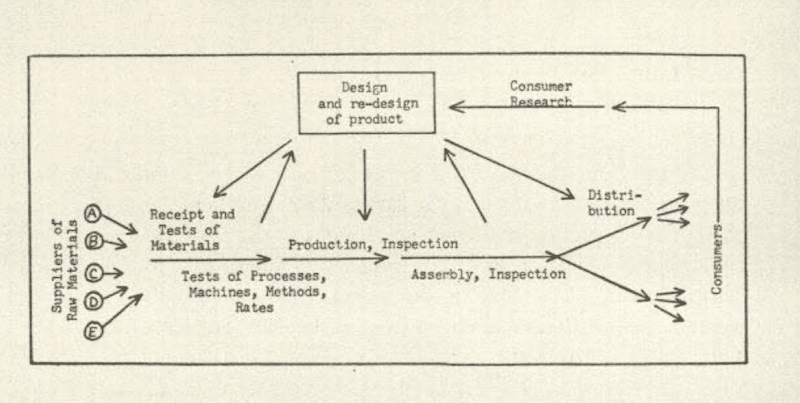By John Hunter, founder of CuriousCat.com.
On the Use of Theory is an article W. Edwards Deming published in 1956. It is one of many of his papers we have posted on our web site.
Though 58 years old the ideas in the article are very useful today and yet many organizations still have not applied these ideas in their management system. The paper includes a version of his famous diagram of the organization as a system.

Statistical techniques have the ability to separate out the responsibilities for action into different levels of administration.
…
The discovery of a special cause of variation, and its removal, are usually the responsibility of someone who is connected directly with some operation. It is his job to find the cause, and to remove it.
…
In contrast there are common causes of defectives, of errors, of low rates of production, of low sales, of accidents. The discovery and correction of common causes is usually the responsibility of someone higher up.
…
The worker at one machine can do nothing about the causes common to all machines.
Today we probably would word things bit differently but the ideas are the same. First you need to identify if the problems are common cause results (most likely) or special cause (something special/identifiable is responsible for the result). Then apply the appropriate thinking depending on what type of problem it is. Unfortunately we still react to most problems as though they are special causes, but in fact most are just the expected result of the system.
If we want to improve going forward (reduce or eliminate that problem) we need to look at the entire system and the processes if it is a common cause result. If it is a special cause we can look at that one case and see what lead to the result and eliminate it (if it was a negative result, or adopt it, if if was a positive result).
Looking for a special cause it the most likely situation (common cause result) will just waste a bunch of time and potentially make things worse. People are good at identifying special causes – even when they don’t exist. So we can usually find something and then put in a countermeasure which may be ok, or may make things worse (and over time we almost certainly will pick up a number that over the entire system make things worse).
Thinking about psychology makes it clear how we identify a special cause when there isn’t one. We have great pattern matching brains. Look at clouds and you will see all sorts of patterns – people’s faces, an airplane, a cat, etc.. That is not because someone painted a cat and put it in the sky. Our brains are great at finding patterns among randomness. This can be very helpful (fast reactions to danger or all those ancestors that someone figured out which plants helped cure which disease), but in problem solving in fairly complex dynamic systems with lots of results for our brains to match patterns to it is often creates problems.
Related: Knowledge About Variation – We Need to Understand Variation to Manage Effectively – Knowledge of Variation – Variation, So Meaningful Yet So Misunderstood


